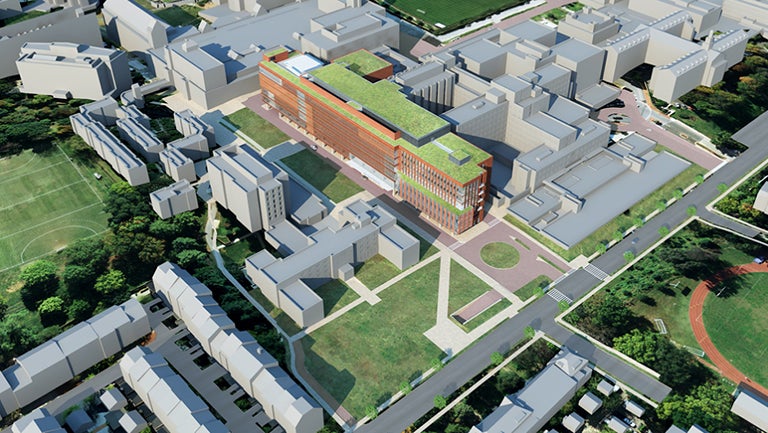Title: New MedStar Georgetown University Hospital Pavilion Approved by City’s Zoning Commission
The new medical/surgical pavilion at MedStar Georgetown University Hospital approved by the District of Columbia Zoning Commission will provide state-of-the-art facilities for Georgetown University Medical Center (GUMC) faculty and students pursuing cutting-edge research and education.

The new medical/surgical pavilion at MedStar Georgetown University Hospital approved by the District of Columbia Zoning Commission last night will provide state-of-the-art facilities for Georgetown University Medical Center (GUMC) faculty and students pursuing cutting-edge research and education.
“Construction of the new pavilion gives new life to the hospital and enables it to continue to serve the community, delivering the most comprehensive and up-to-date care, as well as support research and clinical education,” said GUMC Executive Vice President for Health Sciences Dr. Edward B. Healton. “This will become a valuable asset to the continued success of both MedStar Health in fulfilling its nonprofit mission and to the university’s educational mission and commitment to the citizens of Washington, D.C.”
The new pavilion also will allow for important enhancements to the northern part of the university’s campus, including more green space, reduced traffic congestion, improved pedestrian pathways and upgrades to the university’s facilities plant.
“This project is of significant importance to both MedStar Health and to our university, and will allow us to deepen and expand our ongoing efforts to pursue cutting-edge research and education and further enhance our academic medical mission,” said Georgetown President John J. DeGioia.
Construction is expected to begin in January 2018.
Vibrant Campus, Community
MedStar Health began leasing the hospital premises from the universityand the operating hospital in 2000. The hospital “remains an integral and vibrant part of the university’s campus and the community,” Healton explained.
The hospital provides care for thousands of District residents from all parts of the city and serves as a training site for students from both Georgetown’s School of Medicine and the School of Nursing & Health Studies.
It also trains nearly 500 residents and fellows annually through its accredited graduate medical education programs.
MedStar Health and Georgetown also work collaboratively through GUMC’s research enterprise, which involves hundreds of graduate biomedical students, to help bring innovative therapies from the scientific laboratory to the patient bedside.
Georgetown graduated 535 of these students this past May.
The 450,000-square-foot pavilion is included in the university’s 20-year campus plan, which the commission approved in December 2016.
The project includes 156 private rooms, a new Emergency Department, 32 new operating rooms and a rooftop helipad, all outfitted with the latest technology. The six- story pavilion also will have three levels of underground parking.
Green Space
Throughout the development of theplan, MedStar Health and the university worked with the Georgetown Community Partnership (GCP), local Advisory Neighborhood Commissions (ANCs) and other community and student leaders to ensure that the pavilion would also enhance the campus for students and the community.
In a supporting letter to the zoning commission, the GCP noted that the project will provide substantial benefits for the community and the region.
The GCP also noted the aesthetic aspect of the project, as did Healton.
“The new green space included in the project will reduce traffic by transforming a congested blacktop parking lot into a beautiful, open view of the campus from Reservoir Road and provide a recreation and relaxation space for both students and the surrounding community,” he explained.
“We believe the plans for a modern medical facility on the site are welcome and appropriate and that the community’s interests in traffic reduction and in a green and attractive space at the northern end of the campus are advanced by MedStar’s proposal,” a letter from the ANC 2E stated.
Through the project, MedStar Health and the university will also make substantial investments in the campus infrastructure, constructing an internal roadway behind the medical school and the hospital, and building a bus circle on the northern portion of campus to improve traffic flow.
‘Fantastic’ Plan
Georgetown University Student Association (GUSA) President Kamar Mack (C’19) said that noise, dust, accessibility and safety were among GUSA’s original concerns about the project.
These concerns, he said, were addressed through the creation of early morning quiet hours, centralized foot and vehicle traffic in and out of the construction site and noise monitoring.
“The GCP has provided a great forum to discuss all of these topics, and in my opinion, MedStar has created a fantastic Construction Management Plan that addresses everyone’s concerns,” Mack said.